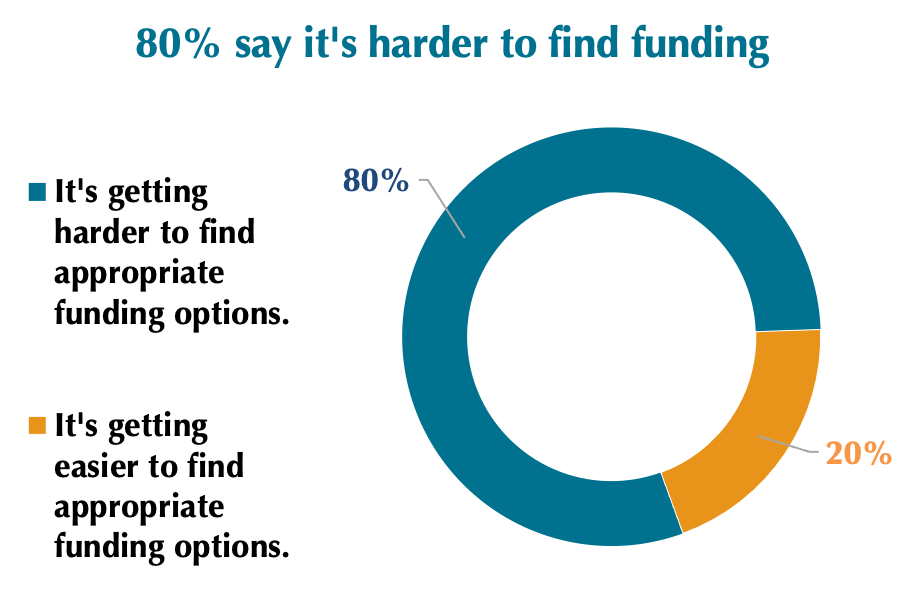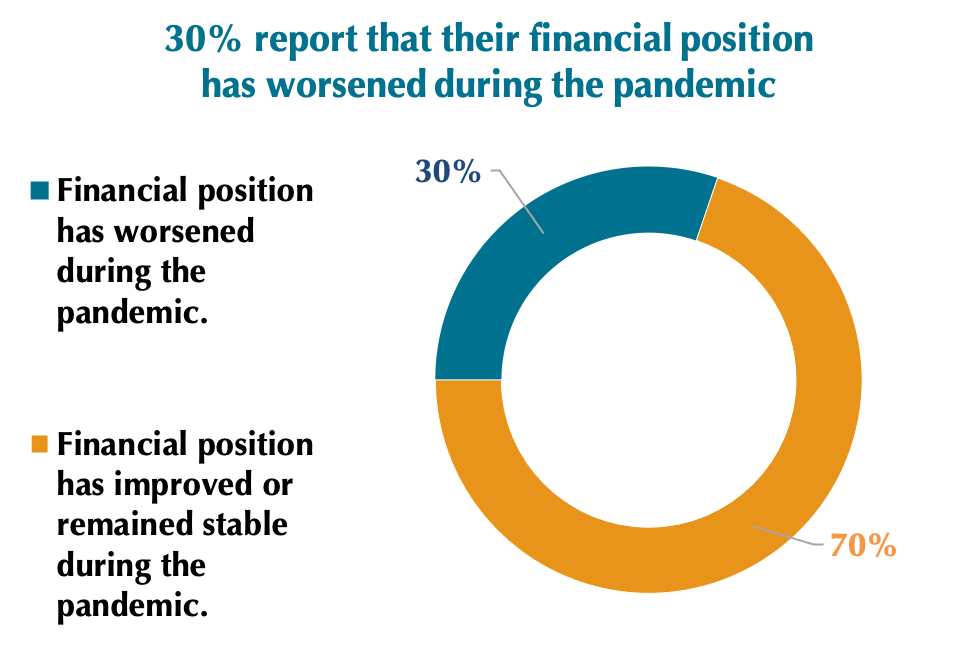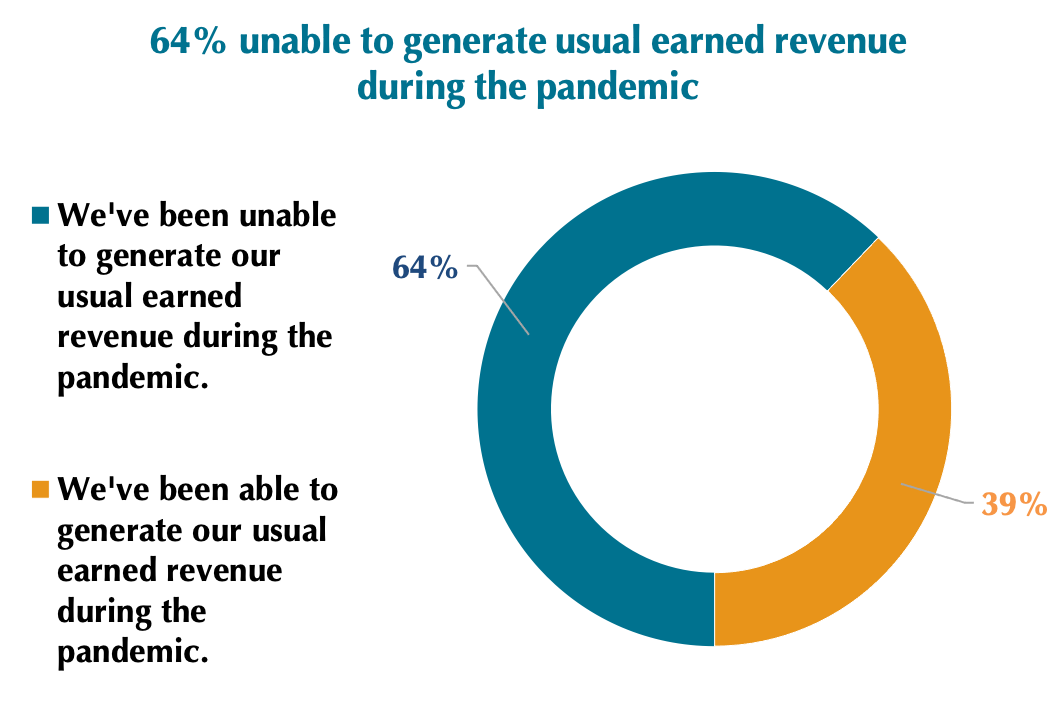
Notwithstanding frequent headlines about their impactful work in communities, London-area nonprofits are struggling to attract the funding they need to do their work during the pandemic and ready themselves for recovery. And it’s been even tougher for small nonprofits according to data that Pillar Nonprofit Network members provided in a micro-survey conducted by Pillar in April. Though some organizations say they’re faring well, it’s clear that many are not, consistent with 2021 forecasts about worsening financial positions for nonprofit organizations and, especially, smaller nonprofits.
 Part of a strategy to capture actionable data about Pillar’s membership and the social impact sector - and act on it – the first edition of Pillar’s “Information for Action” focused on members’ experience of the funding environment and the effects on their financial positions. It was a voluntary and anonymous survey conducted over a few weeks in April. Respondents were able to select among descriptions that most resonated with them, and their answers paint a grim picture for the local impact sector, with difficulty getting funding for basic operating requirements and discouragements to collaboration.
Part of a strategy to capture actionable data about Pillar’s membership and the social impact sector - and act on it – the first edition of Pillar’s “Information for Action” focused on members’ experience of the funding environment and the effects on their financial positions. It was a voluntary and anonymous survey conducted over a few weeks in April. Respondents were able to select among descriptions that most resonated with them, and their answers paint a grim picture for the local impact sector, with difficulty getting funding for basic operating requirements and discouragements to collaboration.
“We're treading water…pretending that it's 2019 without the capacity to operate at 2019 levels.”
 Though the sample size is smaller than usual for a Pillar survey and an opt-in survey can skew to those who feel most strongly about the issue at hand, the quantitative and qualitative data add up to a sector in urgent need of greater support: “It’s a perfect storm," says Paul Seale, Pillar's Manager of Member Engagement. "We know that fewer Canadians are giving and that those who still give are giving less. Many nonprofit organizations had already diversified their funding streams to make them less dependent on donations, but the pandemic disrupted those other earned revenue streams. So they’re really left with foundations and governments. Our members are telling us that it’s not working for everyone – especially small organizations – but not only small organizations. In the words of one respondent, ‘We're treading water - but with less staff and resources - pretending that it's 2019 without the capacity to operate at 2019 levels.’ With a rise in demand for services that many nonprofits are experiencing, we’re worried they’ll drown.”
Though the sample size is smaller than usual for a Pillar survey and an opt-in survey can skew to those who feel most strongly about the issue at hand, the quantitative and qualitative data add up to a sector in urgent need of greater support: “It’s a perfect storm," says Paul Seale, Pillar's Manager of Member Engagement. "We know that fewer Canadians are giving and that those who still give are giving less. Many nonprofit organizations had already diversified their funding streams to make them less dependent on donations, but the pandemic disrupted those other earned revenue streams. So they’re really left with foundations and governments. Our members are telling us that it’s not working for everyone – especially small organizations – but not only small organizations. In the words of one respondent, ‘We're treading water - but with less staff and resources - pretending that it's 2019 without the capacity to operate at 2019 levels.’ With a rise in demand for services that many nonprofits are experiencing, we’re worried they’ll drown.”
“We are always applying for new funding because the funders love ‘new projects’ and that's how we keep our staff employed. Churn baby churn.”
For the purposes of the survey, small nonprofits are those with annual operating budgets less than $100,000 and, by every metric, they reported more severe impacts than medium-sized nonprofits (annual budgets from $100K to $1M), large nonprofits (greater than $1M per annum), and Pillar’s business members, all of whom reported negative impacts closer to the averages for all respondents.
Among the key findings: 
-
80% or respondents report that it’s becoming harder to find appropriate funding options, rising to 90% for small nonprofits
-
30% of respondents reported a worsened financial position, rising to 64% for small nonprofits
-
30% are finding government funders less flexible, rising to 67% for small nonprofits
-
79% find foundations are less flexible during the pandemic, rising to 100% for small nonprofits. Said differently, the number of small nonprofits reporting that foundations were becoming more flexible was zero.
-
20% of all respondents reported having project funding turned down during the pandemic, rising to 52% for small nonprofits
-
64% were unable to generate their usual earned revenue during the pandemic, rising to 83% for small nonprofits
-
34% of respondents reported being turned down for core operational funding, rising to 47% for small nonprofits
As for the action part:
We are committed to acting on the information we ask from our members, beginning with publishing this report so that our members, the sector, and the community better understand the challenges we face.
Here's how else we're using the data and we will update as we complete more actions:
- We are using the results to further shape Pillar programs and services including the new Pillar Community Impact Program (PCIP); the content we share in Member Mail; and future offerings from our Learning & Development program.
- We have already shared early results with Member of Parliament Peter Fragiskatos in a two-page brief seeking support for regulatory reform. You can read that here. We will continue to share the results with elected officials at the local, regional, provincial, and federal level.
- We have shared the results and our members’ words with local media and national media organizations and are seeking members who might share their insights further with media.
- We have shared early results and will continue to share key findings with local partners like the Elgin Middlesex Oxford Workforce Planning and Development Board; regional and provincial sector partners like the Ontario Nonprofit Network; and national partners like Imagine Canada and the Federation of Nonprofit Networks.
- We have already shared results with key contacts at Community Foundations Canada and Philanthropic Foundations Canada and will share with local funders in conversations this Spring.
This is some of what you told us in your own words:
“Many funders switched exclusively to COVID relief and recovery but we don't deal directly with vulnerable populations so we are not eligible, and they don't offer anything else.”
“Because we don't have a … payroll we were ineligible for federal COVID-19 support.”
“It is almost not worth it to seek some government funding, as the requirements to prove that you spent and received every penny of every project makes the admin incredibly time consuming and tedious.”
“Foundations/government are not responsive to continuing coalitions and partnerships that were created during COVID. Funding continues to be tied to individual one-off programs and tied to specific non-profit organizations who may not have the administrative support required to administer the funding, which could be spread between multiple parties.”
“We are always applying for new funding because the funders love ‘new projects’ and that's how we keep our staff employed. Churn baby churn.”
“Turned down for funds for update to website.”
“We have access to COVID specific funding, but we are unsure of our future once this funding goes away. Our service utilization rates have increase 60%-151% across our departments and we won't be able to keep up with demand without this funding.”
“The ‘qualified donee’ aspect remains a challenge. You have to either go for charitable status for so many opportunities or partner with a charity.”
“COVID relief funding has been instrumental in sustaining us through the pandemic - but as we ‘emerge’ from the situation, and language about the pandemic changes from one of emergency support to status quo, we are not yet in a secure enough financial position to apply for standard funding pots. Our revenue streams have not - and will not - recover and we have not had enough time to establish new revenue streams that will sustain us to historic levels. So we're treading water - but with less staff and resources - pretending that it's 2019 without the capacity to operate at 2019 levels.”
“Foundations and major corporations are restricting the funding streams making it more difficult for us as [a museum] to find funders. Many corporations dropped funding opportunities completely or focused on Pandemic assistance and health care.”
“Re: government funding - it is almost not worth it to seek some government funding, as the requirements to prove that you spent and received every penny of every project makes the admin incredibly time consuming and tedious. Re: foundation funding - some are becoming more flexible and some are less. The question that you often see ‘how will you sustain this program?’ always amuses me. We're going to come back to you or another foundation to sustain it. We're a charity, not a business!!”
“As we are a volunteer charity with no permanent employees, we do not qualify.”
“Our financial position improved in the first year of the pandemic, but has worsened since.”
“No core funding.”
